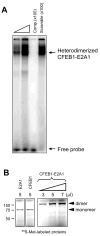Function of E-protein dimers expressed in catfish lymphocytes
- PMID: 17870169
- PMCID: PMC2175175
- DOI: 10.1016/j.molimm.2007.08.001
Function of E-protein dimers expressed in catfish lymphocytes
Abstract
E-proteins are essential class I bHLH transcription factors that play a role in lymphocyte development. In catfish lymphocytes the predominant E-proteins expressed are CFEB (a homologue of HEB) and E2A1, which both strongly drive transcription. In this study the role of homodimerization versus heterodimerization in the function of these catfish E-proteins was addressed through the use of expression constructs encoding forced dimers. Constructs expressing homo- and heterodimers were transfected into catfish B cells and shown to drive transcription from the catfish IGH enhancer. Expression from an artificial promoter containing a trimer of muE5 motifs clearly demonstrated that the homodimer of E2A1 drove transcription more strongly (by a factor of 10-25) than the CFEB homodimer in catfish B and T cells, while the heterodimer showed intermediate levels of transcriptional activation. Both CFEB1 and E2A1 proteins dimerized in vitro, and the heterodimer CFEB1-E2A1 was shown to bind the canonical muE5 motif.
Figures




Similar articles
-
Evolution of transcriptional control of the IgH locus: characterization, expression, and function of TF12/HEB homologs of the catfish.J Immunol. 2004 Nov 1;173(9):5476-84. doi: 10.4049/jimmunol.173.9.5476. J Immunol. 2004. PMID: 15494495
-
Regulation of immunoglobulin gene transcription in a teleost fish: identification, expression and functional properties of E2A in the channel catfish.Immunogenetics. 2005 May;57(3-4):273-82. doi: 10.1007/s00251-005-0793-3. Epub 2005 Apr 8. Immunogenetics. 2005. PMID: 15900499 Free PMC article.
-
Evolution of vertebrate E protein transcription factors: comparative analysis of the E protein gene family in Takifugu rubripes and humans.Physiol Genomics. 2005 Apr 14;21(2):144-51. doi: 10.1152/physiolgenomics.00312.2004. Epub 2005 Feb 15. Physiol Genomics. 2005. PMID: 15713784
-
Characterization of an Oct1 orthologue in the channel catfish, Ictalurus punctatus: a negative regulator of immunoglobulin gene transcription?BMC Mol Biol. 2007 Jan 31;8:8. doi: 10.1186/1471-2199-8-8. BMC Mol Biol. 2007. PMID: 17266766 Free PMC article.
-
An IgH enhancer that drives transcription through basic helix-loop-helix and Oct transcription factor binding motifs. Functional analysis of the E(mu)3' enhancer of the catfish.J Biol Chem. 2001 Jul 27;276(30):27825-30. doi: 10.1074/jbc.M100110200. Epub 2001 May 25. J Biol Chem. 2001. PMID: 11375977
Cited by
-
Interaction between E-protein and Oct transcription factors in the function of the catfish IGH enhancer.Dev Comp Immunol. 2008;32(10):1105-10. doi: 10.1016/j.dci.2008.04.001. Epub 2008 May 7. Dev Comp Immunol. 2008. PMID: 18511119 Free PMC article.
References
-
- Bain G, Robanus Maandag EC, Izon DJ, Armsen D, Kruisbeek AM, Weintraub BC, Krop I, Schlissel MS, Feeney AJ, van Roon M, van der Valk M, te Riele HPJ, Berns A, Murre C. E2A proteins are required for proper B cell development and initiation of immunoglobulin gene rearrangements. Cell. 1994;79:885–892. - PubMed
-
- Benezra R. An intermolecular disulfide bond stabilizes E2A homodimers and is required for DNA binding at physiological temperatures. Cell. 1994;79:1057–1067. - PubMed
-
- Blackwell TK, Weintraub H. Differences and similarities in DNA-binding preferences of MyoD and E2A protein complexes revealed by binding site selection. Science. 1990;250:1104–1110. - PubMed
Publication types
MeSH terms
Substances
Grants and funding
LinkOut - more resources
Full Text Sources

